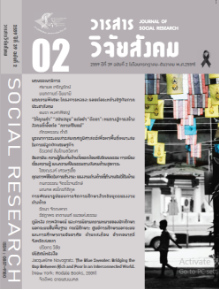โครงการหลวง: รอยต่อระหว่างรัฐกับภาคประชาสังคม
Main Article Content
บทคัดย่อ
ในโครงสร้างสังคมไทยปัจจุบัน โครงการหลวงได้ทำหน้าที่ในฐานะสถาบันทางสังคม หลังจากที่ระบอบกษัตริย์ได้ถูกลดอำนาจหน้าที่ในสถาบันการปกครองหลังการเปลี่ยนแปลงการปกครอง พ.ศ.2475 เป็นการสร้างโครงสร้างความสัมพันธ์ระหว่างสถาบันกษัตริย์กับประชาชนในรูปแบบที่แตกต่างไปจากเดิม
The Royal Project: Interface between Government and Public Sector
In this article, functional analyses of “The Royal Project” initiated by the late King Rama IX are presented. The relationship between the Royal Project and ethnic marginal people started from the project adopting philanthropy concept at first, and then later shifting to adopting social/community development concept. At present the Royal Project is functioning as a civil society organization, responding to the needs of the people in areas where government social services cannot be provided adequately. The development process of the Royal Project follows the pattern of development of civil society movement in Thailand. The project has been giving social space to marginal people in Thai society. Although not quite successful, the inclusive de-marginalization process has brought ethnic minorities closer to the center of power leading toward a more realistic culturally plural society.
In the present Thai social structure, the Royal Project has been functioning as a social institution representing the monarchy after the absolute power of the monarchy in the political institution has been replaced in 1932.
Article Details
1) บทความนี้เป็นลิขสิทธิ์ของสถาบันวิจัยสังคม จุฬาลงกรณ์มหาวิทยาลัย แต่ความคิดเห็นและเนื้อหาเป็นของผู้แต่ง
2) ทัศนะและความคิดเห็นที่ปรากฏในบทความในวารสารวิจัยสังคมและปริทัศน์ สถาบันวิจัยสังคม จุฬาลงกรณ์มหาวิทยาลัย ถือเป็นความรับผิดชอบของผู้แต่งบทความนั้น และไม่ถือเป็นทัศนะและความรับผิดชอบของกองบรรณาธิการวารสารวิจัยสังคมและปริทัศน์ สถาบันวิจัยสังคม จุฬาลงกรณ์มหาวิทยาลัย กองบรรณาธิการไม่สงวนสิทธิ์ในการคัดลอก แต่ให้ระบุถึงการอ้างอิง


